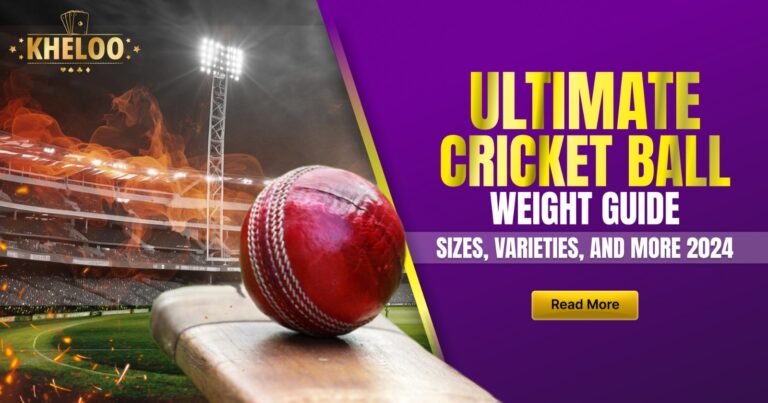Cricket! It is a sport where strength meets strategy. And let’s not forgets the silent hero – the cricket ball. This sphere of wonder, alongside the wicket and the bat, orchestrates the entire match. But have you ever stopped to ponder the intricacies of this little ball? Fear not, cricket fanatics and aspiring bowlers, for we’re about to delve into the fascinating world of cricket ball weight, size, and even its surprising origins!
During the 16th century the cricket balls were accurately crafted by hand. These balls, quite unlike their modern counterparts, boasted different weights and sizes. Fast forward to today, and cricket balls are marvels of modern manufacturing!
What’s hiding beneath the leather exterior? Brace yourselves, for the answer is a natural wonder – cork! This core, meticulously shaped into a sphere using fancy machines, forms the heart of the cricket ball. Imagine a tiny, bouncy ball of cork – that’s the base!
But a core alone wouldn’t make much of a game, would it? Enter the leather – a specially cut sheet meticulously wrapped around the cork core. Now, how do you keep this duo together? Strong strings or nylon come to the rescue, stitching everything into a neat, playable ball.
The Finishing Touches:
Finally, the ball gets a special treatment – a glossy polish that makes it shine like a champion. And to mark its official status, a manufacturer’s stamp is proudly imprinted on the leather surface. Voila! Our cricket ball is ready for action.
Men in the big leagues get a heavier ball, like a hefty apple (around 5.5 to 5.75 ounces). This means the bowlers can throw super-fast, making it a real test for the batsmen to hit those runs!
For our future cricket stars, there are lighter balls, more like a not-so-big apple (think 4.94 to 5.31 ounces). This way, youngsters can learn the ropes safely and have a blast playing the game. Even women’s cricket uses slightly lighter balls compared to the men’s game.
Why the Weight Difference? It’s All About Challenge!
Heavier balls mean the ball flies faster, making it super hard for the batsman to hit. Lighter balls are easier to control, perfect for young players who are still developing their skills.
So next time you watch cricket, remember the ball! This little sphere, with just the right weight, is a key part of what makes cricket such a fun and challenging game!
Explaining the Cricket Ball:
The world of cricket, with different rules and gear may be tough for newcomers. But fret no more! Today, we’ll delve into the curious case of the cricket ball – its weight, its size, and why it matters.
One Ball (Kind Of) Rules Them All
Now, this might surprise you, but both national and international cricket matches utilize balls of the same weight. Shocking, right? On average, a cricket ball hefts between 156 and 163 grams, roughly the weight of your trusty smartphone!
Size Matters, Literally:
But weight isn’t the only story. Let’s shift our focus to size. A typical cricket ball boasts a circumference of 8.8 to 9 inches around its, well, belly. Imagine a medium grapefruit – that’s about the right picture!
The All-Powerful ICC and Official Ball Rules
The esteemed International Cricket Council (ICC) dictates the official size and weight for top-tier cricket matches. However, here’s a mind-bender: these balls aren’t created equal!
Balls for Budding Cricketers:
Just like clothes come in various sizes, cricket balls do too, catering to players of different ages. Youngsters under 13 get a lighter and smaller ball, weighing roughly 133 to 144 grams. Think of a slightly deflated tennis ball – perfect for safe and easy handling!
Senior Players, Senior Balls
For players 13 and above, the game steps up a notch, and so does the ball. They graduate to the standard size and weight we discussed earlier.
Also Read: Sachin Tendulkar’s Wealth: How Much Does He Earn in Rupees?
A Handy Table for the Curious
Want a quick comparison of junior and senior cricket ball sizes and weights? Look no further!
| Age Group | Weight (Grams) | Circumference (cm) | Diameter (cm) |
| Under 13 | 133-144 | 20.5-22.0 | 7.1-7.2 |
| 13 and Over | 155-163 | 22.4-22.9 | 6.5-7.0 |
drive_spreadsheetExport to Sheets
Weighty Implications: A Lighter Ball’s Secret
The seemingly minor weight difference between junior and senior balls has a surprisingly significant impact on gameplay. A lighter ball translates to less force behind it, making it trickier to swing and bowl at high speeds.
A World Beyond the Red Ball
Prepare to be astonished! The classic red ball isn’t the only cricket ball on the field. Stay tuned for our exploration into the fascinating world of different cricket balls!
Also Read: Top 20 Wicket Takers in IPL History (2008-2024)
The Wondrous World of Cricket Balls:
The Classic Red: Every cricket match, from dusty streets to fancy stadiums, needs the red cricket ball! It’s been around forever, the same size and weight as all the others. Think of it as the granddaddy of cricket balls, the one used in fancy first-class and test matches, sometimes even popping up in one-day games. But here’s a tricky thing: under those bright night lights, red balls like to play hide-and-seek, turning a brownish shade that’s hard to see.
- The White Knight: Enter the white cricket ball, a shining hero in the night! Its bright color cuts through the darkness like a champion. Some players even say it’s a bit harder, making it a dream for bowlers who want the ball to swing all over the place. White balls are the stars of shorter, faster games like T20 and ODIs, where seeing the ball is super important.
- Pink Power: Now, get this! The newest ball on the scene is the pink cricket ball. Invented in the 2000s because night matches were a nightmare with white balls disappearing against white clothes, this pink ball is a game-changer. Not only can you see it perfectly under those harsh lights, but it’s also tougher than a white ball, lasting longer in those long test matches. Size and weight? Same as always, just a flashier outfit!
- Practice Makes Perfect: Cricket balls get hammered, so for practice, there are special training balls built to last. These champions, sometimes with a cool foam center, can take endless throws and hits. They feel just like a real match ball, but they’re lighter so you don’t get hurt. Think of them as training wheels for your batting and bowling skills!
- The Wind Warrior: Finally, there’s the wind ball. This little guy is for a different kind of cricket – street cricket on concrete! Made of plastic for extra toughness, it’s smaller and lighter than a regular ball, perfect for those epic street battles.
Cricket balls might be small, but they’re a big part of the game! From the classic red to the flashy pink, each ball has a special job. They might all be the same size and weight, but the way they act on the field is a whole different story!

Cricket Ball FAQs: A Rundown for the Curious Cricketer!
- The Deal Between Regular and Training Balls:
Imagine a bowling machine that throws bricks! That’s a regular cricket ball – hard and heavy. Training balls, on the other hand, are the softies of the bunch. They’re lighter and easier on your arms, perfect for practice and lasting longer through countless throws.
- A Rainbow of Cricket Balls: Decoding the Colors!
Think of cricket balls like chameleons, but instead of blending in, they need to stand out! There are the classic red balls, perfect for daytime matches. But when the sun sets, things get tricky. Red can look brownish under lights, so the white ball swoops in like a knight in shining armor, easy to see against the night sky.
- Pink Power! The Newest Ball on the Block:
The newest addition to the cricket ball party is the pink one! Invented in the 2000s to solve the white-ball-blending-in-with-clothes problem, this flashy ball is a lifesaver for night matches. Not only is it super visible, but it’s also tougher than white balls, lasting those long test matches. Fancy outfit? Check! Superpowers? Check! - How Much Does a Cricket Ball Weigh?
Cricket balls weigh about as much as a chocolate bar (155 grams) and are as wide as a really fat lime (almost 3 inches), according to the big boss of cricket rules! - So, why all the colors?
It’s simple! Cricket balls need to be seen clearly, no matter the time of day or what the batsman is wearing. That’s why we have red for day games, white for night games under lights, and pink for those extra-long night test matches where white just won’t do.
Bonus Fun Fact! Cricket balls have leather on the outside and cork on the inside. But training balls can sometimes have a soft foam center, and wind balls, for those concrete pitch battles, are made of super-tough plastic!




Comments are closed.